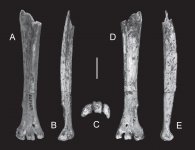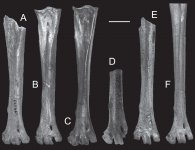Systematic paleontology
Order ACCIPITRIFORMES Vieillot
Family ACCIPITRIDAE Vieillot
Genus Buteogallus Lesson, 1830, Traité d’Orn., livr. 2, p. 83. Type, by monotypy, Buteogallus cathartoides Lesson, 1830 = Falco aequinoctialis J. F. Gmelin, 1788.
Synonym. Amplibuteo Campbell, 1979: 77; type species by original designation Amplibuteo hibbardi Campbell, new synonymy
Characters of the tarsometatarsus described by Campbell (1979: 77) as diagnostic of ‘Amplibuteo’, but recorded by him as present in Buteogallus (= ‘Harpyhaliaetus’ and ‘Heterospizias Sharpe’, see diagnosis of ‘Miraquila’ Campbell 1979: 74), include: ‘(1) inner
calcaneal ridge of hypotarsus projecting posteriad at approximately 60–70o to vertical axis of shaft [= ‘Harpyhaliaetus’]; (2) intercotylar area elevated slightly [= ‘Heterospizias’ and Buteogallus]; (3) edge of shaft external to outer calcaneal ridge of hypotarsus without ridge [more similar to ‘Harpyhaliaetus’, character of specific value, variable in Buteogallus, see Suárez & Olson 2009b: 250]; (4) anterior metatarsal groove moderately deep [= ‘Heterospizias’ and Buteogallus]; (5) internal anterior metatarsal ridge only slightly developed [= Buteogallus];
(6) attachment of tibialis anticus not separated from external anterior metatarsal ridge by groove [= ‘Harpyhaliaetus’ and ‘Heterospizias’]; (7) middle trochlea short, turned significantly externally in anterior view [= ‘Harpyhaliaetus’]; (8) internal trochlea rotated posteriad such that posteromedial edge is at same level as posterolateral edge of middle trochlea [= ‘Heterospizias’ and Buteogallus]; (9) internal trochlea projecting distad beyond middle trochlea and rotated significantly externally in anterior view [= ‘Harpyhaliaetus’]; (10) internal trochlea with distinct angular proximolateral projection [= ‘Harpyhaliaetus’ and
‘Heterospizias’].’ Therefore, the extinct taxa currently placed in ‘Amplibuteo’ are treated herein under Buteogallus, as B. woodwardi (L. Miller, 1911) new comb., B. hibbardi (Campbell, 1979) new comb., and B. concordatus (Emslie & Czaplewski, 1999) new comb., which are all
members of the Buteogalline radiation among extinct Accipitridae from America (cf. Olson 2007, Suárez & Olson 2008, 2009b). Specimens of the new species also replicate the general skeletal morphology present in the living B. solitarius (or vice versa), being part of a small (apparently monophyletic) assemblage of allopatric-allochronic fossil species that includes B. concordatus and B. woodwardi, from North America, and B. hibbardi from South America.
Buteogallus irpus sp. nov.
Wolf Hawk / Gavilán Lobo
References:
Titanohierax gloveralleni: Woods 1980: 8 (part).
Titanohierax sp.: Olson & Hilgartner 1982: 28.
Amplibuteo sp.: Suárez & Arredondo 1997: 100.
Amplibuteo woodwardi: Suárez 2004: 121.
Holotype.—Left tarsometatarsus lacking proximal end, USNM PAL 299573 (Figs. 1A‒E, 2A; not ‘USNM 244573’ [lapsus calami], as reported by Olson & Hilgartner 1982: 28). Collected by Charles Woods under 60 cm of red earth, at the type locality, on 24 April 1978. This specimen was incorrectly cited as ‘a tarsometatarsus lacking its distal end (USNM 244573, from Cueva de las Abejas)’ by Steadman et al. (2019: 328).
Paratype.—Cueva de Sandoval (Sandoval III low deposit), c.4 km south of Vereda Nueva, Caimito municipality, Artemisa (formerly La Habana) province, Cuba: partial skeleton WS 365, with one cervical (axis) and three thoracic vertebrae, seven fragments of ribs, fragmentary pelvis, proximal fragmentary right humerus, distal fragments of left humerus, segment of shaft of left ulna, left fragmentary femur without distal end, proximal and distal fragmentary ends of right femur, shaft of left tibiotarsus, proximal right fibula, left tarsometatarsus (lacking inner calcaneal ridge, part of the proximal end of the metatarsal facet, wing of trochlea II and posterior surface of trochlea III) (Fig. 2B), left digit I-phalanx 1 and 2, left digit III-phalanx 2 and 3, right digit III-phalanx 4, right digit IV-phalanx 4. Collected by WS on 2 March 1995. Quaternary, probably late Pleistocene, but not directly dated (see Suárez 2000). For illustrations and description see Suárez (2004: 121‒123, Figs. 1–2).
Measurements of holotype.—Total length as preserved: 124.9 mm; proximal width at distal level of tubercle for tibialis anticus: 17.0 mm; width of shaft at midpoint: 13.2 mm; minimum width of shaft: 11.8 mm; minimum width of shaft at proximal end of metatarsal facet: 13.0 mm; depth of lateral side at proximal end of metatarsal facet: 9.8 mm; distance from proximal edge of metatarsal facet to inner inter-trochlear notch: 30.3 mm; distal width: 27+ mm; width of trochlea III: 8.3 mm; depth of trochlea IV: 12.2 mm (Table 1).
Diagnosis.—Resembles B. woodwardi and B. hibbardi in size and general morphology, but tarsometatarsus more robust, with shaft expanded at distal end, and trochleae relatively shorter in B. irpus.
Measurements of paratype.—See Suárez (2004: 123–124, Table 1, Fig. 3), Table 1.
Type locality and age.—Cueva de las Abejas (18°01’N, 71°40’W; c.20 m), near Cabo Rojo, 8 km south-east of Pedernales, 1.5 km north of Highway 44, Pedernales province, Dominican Republic. Quaternary, probably late Pleistocene, but not directly dated (see Olson & Hilgartner 1982: 28, Steadman et al. 2019: 321).
Etymology.—From Latin irpus, = wolf, in reference to the ecological role played by this large raptor in controlling the regional ‘megafauna’ on the two largest islands of the Greater Antilles, occupying the ecological niche of a carnivorous mammal (cf. Arredondo 1976, Morgan et al. 1980).
Status.—Extinct, known only from fossil material.
Fred
Figure 1. Holotype left tarsometatarsus (USNM PAL 299573) of Buteogallus irpus sp. nov., in anterior (A), medial (B), distal (C), posterior (D) and lateral (E) views. Scale = 2 cm.
Figure 2. Tarsometatarsi of large extinct West Indian and North American Accipitridae in anterior view (A‒F). Buteogallus irpus sp. nov.: (A) left without proximal end (holotype, USNM PAL 299573), (B) left
(paratype, WS 365 [part of the proximal end of the metatarsal facet is lacking due to fracture, so the complete specimen would be wider at this point]). B. woodwardi new comb.: (C) left (RLB D1970). Gigantohierax itchei: (D) distal third of right without trochlea IV (holotype, MNHNCu 75.4869). Titanohierax gloveralleni: (E) right
without proximal end and trochlea II (holotype, MCZ 2257). Buteogallus borrasi: (F) right (CZACC 400-659). Images D‒F are reversed to facilitate comparisons. Scale = 2 cm.


 bioone.org
bioone.org







